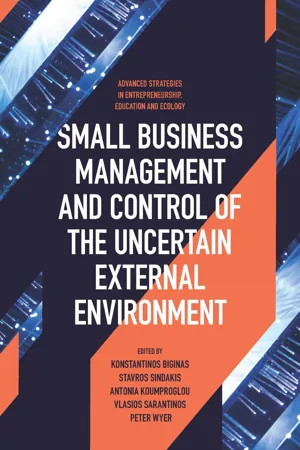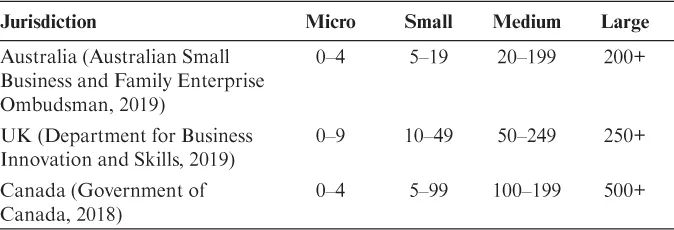![]()
Chapter 1
The Distinctiveness of Small Businesses
Shaun Bowman and Peter Wyer
Chapter Contribution
Small businesses are ubiquitous across the globe and they form a large part of the enterprise population in most economies. Understanding of the sector remains sketchy, despite there being concerted efforts since the 1970s to conduct research to give insight into the behaviour of small businesses.
All businesses have to cope with their external environments, but the resource poverty of small businesses means that they may suffer disproportionately, and they certainly do not have access to the resources, financing and knowhow that large firms have to inform them about the most effective way to manage their resources, minimise threats and optimise opportunities in the environment. This chapter provides a holistic framework to enable deeper understanding of subsequent chapters.
Introduction
Our focus within this book is upon how growth-achieving small businesses cope with uncertain operating environments and create and implement innovative and sustainable strands of strategic development.
Within this opening chapter, we provide summary contextualisation of the distinctiveness of small business compared with well-resourced large companies – effectively, a contextual frame of reference to inform the reader’s study of subsequent chapters. We clarify through the provision of a working definition the nature and size classifications of micro-enterprises and small businesses that form our predominant focus, provide insight into the key potentially enabling and constraining characteristics that distinguish smaller enterprises from large organisations and highlight the significance and importance of small business in terms of contribution to social and economic development.
In most economies, small businesses make up most of the total enterprise population. The definition of such businesses is difficult, but generic characteristics include quantitative measures such as small numbers of employers and qualitative considerations of how risk capital is often provided by owner–managers who also have significant hands-on input to the management and control of the business.
Notwithstanding the significance of small businesses, understanding of the sector remains patchy. A rigorous and robust research base has unfolded over recent years, providing rich insight in many areas of entrepreneurship and small business development but only a surface grasp of key issues in others. Moreover, there is an ongoing tendency in parts of academia and the world of small business support provision to view and treat the small business as if they are ‘little big businesses’. Indeed, the support given to them by national and local governments is often tainted by this ‘microcosm of large company’ assumption, leading to their specific needs being inadequately addressed. The sheer size of the sector and the significance of the potential developmental contribution makes it important that policy design and implementation is backed-up by research evidence that enhances understanding.
We aspire throughout this book to contribute to one such existing area of hazy and surface understanding of small business development – how growth achieving small businesses copes with, manage and control their often-turbulent external environments. Thus, addressing key issues such as what constitutes effective small business strategic management. The remainder of this chapter is devoted to providing the foundations, context and reference points to aid the reader’s journey through the subsequent chapters.
Uncertain Business Environments
As stated above, the theme of this book is the approaches of small businesses in the context of managing and controlling their uncertain external environments. By this, we mean that conditions are constantly changing for the business within its environment and it struggles to influence the factors that make up its external environment, either because it does not have requisite knowledge and skills or is unable to access resources that would enable it to exercise control. This results in a lack of resilience and ability to predict, react and modify in the face of gradual change and unexpected disruption.
The dynamic nature of the business environment is due to several factors, amongst them pressures caused by globalisation, trade and regulatory liberalisation and modernisation which increase risk (Akhtar, 2018) and heighten competition (Liñán, Paul, & Fayolle, 2019). These have acted as drivers for different approaches to coping with the external environment leading to more innovative and flexible responses focussing on outcomes that incorporate increased efficiency, effectiveness, productivity, quality and key stakeholder satisfaction.
Besides the constant and unremitting pressures described in the foregoing paragraph, there can also be sporadic, but significant events that occur in the business environment. The current situation with COVID-19 is a particularly good example of how the landscape can swiftly alter for a business. Businesses need to prepare for such dramatic changes in their external environment to enable them to respond in an effective manner.
Small businesses could be more sensitive to or impacted by such changes because of the limitations placed upon them by their size which mean they may have restricted access to knowledge, skills and resources affecting product and process development in the widest sense. This deficiency has been termed resource poverty (Welsh & White, 1981). However, it has also been claimed that a lack of relevant personnel, expertise and finance can also drive innovation by pushing small businesses to find flexible and unique solutions to overcome barriers (Clohessy & Acton, 2019).
Defining a Small Business?
There is no universal definition of what a small business is (Storey, 1994; Tonge, 2001). They are diverse and complex, and despite the label, have differing needs. So, does it matter that a business is designated as small or not? It can because government policy may provide benefits to businesses that are small, for example, the US Small Business Administration (SBA) has a commitment to award 23% in value of government contract to small businesses. The UK government allows small companies to submit abbreviated accounts. Other benefits could include tax breaks or support with loans and grants.
It also matters from an academic standpoint because we need to interpret and understand enterprise decision-making and performance in the context of their size. The ability to define and classify small businesses as subjects for analysis better informs research into the area.
So, the reason for identifying a small and medium-sized enterprise (SME) and categorising it according to size is so it can receive special attention, either from a policy perspective or a research or business support standpoint. We wish to understand the behaviour of small businesses and unless the definition is suitable and reliable this is difficult. The choice of definition drives results (Headd & Saade, 2008) and mixing data can distort results. Despite this, a study found that there was no consistent approach to the definition of SMEs or their sub-categories in a range of 217 articles in 20 specialist entrepreneurship and small business journals.
In general terms, a small business is a privately owned company, partnership or sole trader that is smaller in employment and financial terms than a large business. The definition of what ‘small’ is can be quite complex (see SBA, 2019, e.g., of different definitions for different industries even within the same sector) because the explanation can change:
From sector to sector, for example, the SBA has different levels of employment from industry to industry. Their starting point for the manufacturing sector is 500 employees whilst for the retail sector is 100 (SBA, 2020).
From jurisdiction to jurisdiction (see Table 1).
Table 1. Business Size Criteria Across Jurisdictions.
In addition, definitions of what constitutes a small business may be reviewed periodically and change over time to reflect economic and social changes (Table 1).
For example, the SBA recently (22 February 2020) amended industry-specific financial-based measures upwards to take account of inflation since the last amendment in 2014 (SBA, 2020).
The normal way of defining a small business is by reference to a quantitative threshold, but as noted above small businesses are not homogenous and can be differentiated along many criteria, such as size, age, sector, legal structure, business model and objectives with the result that there is no one size fits all approach to them. The main problem is that jurisdictions differ widely in their classification of SMEs, for example. India uses levels of investment whilst South Africa uses number of employees and revenue (Wittig, 1998). The most common forms of criteria used are the following:
The European Union (EU) uses several criteria to determine a business’s size (Table 2).
Financial measures are one way of defining the type of business. This can either be by referring to the overall amount of revenue generated or by the value of the balance sheet. The UK also uses financial values to identify the level of compliance with financial reporting by small companies. An advantage of using financial measures is that they can be re...

